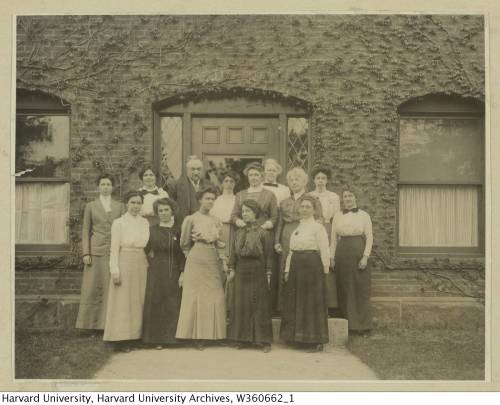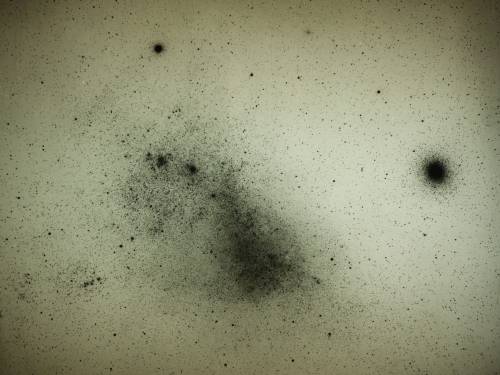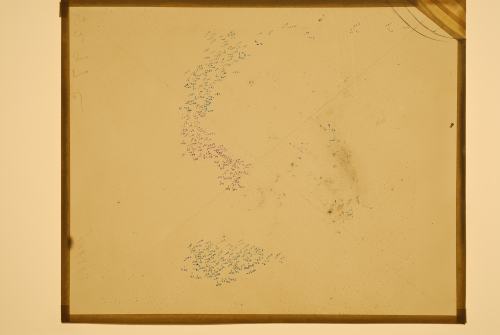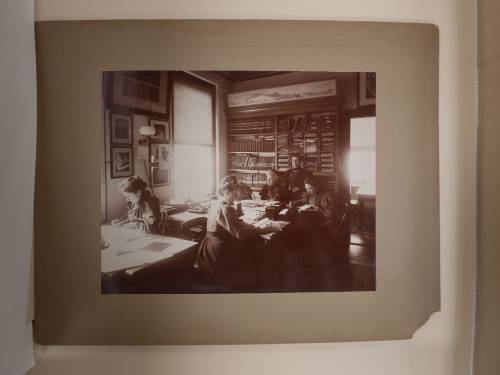By Kandis Elliot, Mo Fayyaz, University Of Wisconsin, Madison

by Kandis Elliot, Mo Fayyaz, University of Wisconsin, Madison
brought to you by Graphic Services for Science and Graphic Biology
More Posts from Contradictiontonature and Others




This team of early female astronomers created the star classification system we use today.
In the late 19th century, astronomy was a growing field. At the time, Edward Pickering, the director of the Harvard College Observatory, was working to create a classification system for stars by capturing the light from these distant celestial objects onto photographic glass plates. A team of female assistants and astronomers meticulously maintained and analyzed these delicate negatives. In her new book, The Glass Universe: How the Ladies of the Harvard Observatory Took the Measure of the Stars, Dava Sobel shares the stories of these female “human computers” and how their work helped to advance the field of astronomy and the role of women in science.
This team of astronomers included Williamina Fleming, who was once Pickering’s maid but eventually became a supervisor to the group and went on to identify hundreds of variable stars. And Henrietta Swan Leavitt’s observations about the luminosity of stars would shape later ideas about the expanding universe.
Listen to the interview here.
[Photos courtesy of The Glass Universe]

Even after someone is declared dead, life continues in the body, suggests a surprising new study with important implications.
Gene expression — when information stored in DNA is converted into instructions for making proteinsor other molecules — actually increases in some cases after death, according to the new paper, which tracked postmortem activity and is published in the journal Open Biology.
“Not all cells are ‘dead’ when an organism dies,” senior author Peter Noble of the University of Washington and Alabama State University told Seeker. “Different cell types have different life spans, generation times and resilience to extreme stress.”
In fact, some cells seem to fight to live after the organism has died.
“It is likely that some cells remain alive and are attempting to repair themselves, specifically stem cells,” Noble said.

Today, scientists working with telescopes at the European Southern Observatory and NASA announced a remarkable new discovery: An entire system of Earth-sized planets. If that’s not enough, the team asserts that the density measurements of the planets indicates that the six innermost are Earth-like rocky worlds.
And that’s just the beginning.
Three of the planets lie in the star’s habitable zone. If you aren’t familiar with the term, the habitable zone (also known as the “goldilocks zone”) is the region surrounding a star in which liquid water could theoretically exist. This means that all three of these alien worlds may have entire oceans of water, dramatically increasing the possibility of life. The other planets are less likely to host oceans of water, but the team states that liquid water is still a possibility on each of these worlds.
Summing the work, lead author Michaël Gillon notes that this solar system has the largest number of Earth-sized planets yet found and the largest number of worlds that could support liquid water: “This is an amazing planetary system — not only because we have found so many planets, but because they are all surprisingly similar in size to the Earth!”
Co-author Amaury Triaud notes that the star in this system is an “ultracool dwarf,” and he clarifies what this means in relation to the planets: “The energy output from dwarf stars like TRAPPIST-1 is much weaker than that of our Sun. Planets would need to be in far closer orbits than we see in the Solar System if there is to be surface water. Fortunately, it seems that this kind of compact configuration is just what we see around TRAPPIST-1.”
Continue Reading.

It’s a textbook moment centuries in the making: more than 200 years after scientists started investigating how water molecules conduct electricity, a team has finally witnessed it happening first-hand.
It’s no surprise that most naturally ocurring water conducts electricity incredibly well - that’s a fact most of us have been taught since primary school. But despite how fundamental the process is, no one had been able to figure out how it actually happens on the atomic level.
“This fundamental process in chemistry and biology has eluded a firm explanation,” said one of the team, Anne McCoy from the University of Washington. “And now we have the missing piece that gives us the bigger picture: how protons essentially ‘move’ through water.”
Continue Reading.

For #WorldBeeDay, here’s a look at the chemistry behind the honey some bees produce: https://ift.tt/2GV5qtq https://ift.tt/2LJpsIe

Bismuth is one of the weirdest-looking elements on the Periodic Table, but its internal properties just got even stranger. Scientists have discovered that at a fraction of a degree above absolute zero (-273.15°C), bismuth becomes a superconductor - a material that can conduct electricity without resistance.
According to the current theory of superconductivity, that doesn’t make a whole lot of sense, because for 40 years now, scientists have assumed that superconducting materials must be abundant in free-flowing mobile electrons. But in bismuth, there’s just one mobile electron for every 100,000 atoms.
“In general, compounds that exhibit superconductivity have roughly one mobile electron per atom,” Srinivasan Ramakrishnan from the Tata Institute of Fundamental Research in India explained to Chemistry World.
“However, in bismuth, one mobile electron is shared by 100,000 atoms – since [the] carrier density is so small, people did not believe bismuth will superconduct.”
Continue Reading.

A French man who lives a relatively normal, healthy life - despite missing 90 percent of his brain - is causing scientists to rethink what it is from a biological perspective that makes us conscious.
Despite decades of research, our understanding of consciousness - being aware of one’s existence - is still pretty thin. We know that it’s somehow based in the brain, but then how can someone lose the majority of their neurons and still be aware of themselves and their surroundings?
First described in The Lancet in 2007, the case of the man with the missing brain has been puzzling scientists for almost 10 years.
Read more…

After the four new additions, here’s a look at the origins of all the element names in the periodic table! High-res image/PDF: http://wp.me/p4aPLT-1Ru
Also featured in The Conversation UK alongside an article from Professor Mark Lorch here: https://goo.gl/g60pGU


Happy Halloween!
Guncotton in a pumpkin and the decomposition of hydrogen peroxide catalysed by potassium iodide, on the roof of the Ri.
-
 yukitsen liked this · 8 months ago
yukitsen liked this · 8 months ago -
 furuit reblogged this · 5 years ago
furuit reblogged this · 5 years ago -
 sarah-bbee liked this · 5 years ago
sarah-bbee liked this · 5 years ago -
 wildstorkmel liked this · 5 years ago
wildstorkmel liked this · 5 years ago -
 satan-general-irl liked this · 6 years ago
satan-general-irl liked this · 6 years ago -
 acerbicaftertaste reblogged this · 7 years ago
acerbicaftertaste reblogged this · 7 years ago -
 aqua-kat liked this · 7 years ago
aqua-kat liked this · 7 years ago -
 haliotis94 reblogged this · 7 years ago
haliotis94 reblogged this · 7 years ago -
 vahre liked this · 7 years ago
vahre liked this · 7 years ago -
 petnat24 liked this · 7 years ago
petnat24 liked this · 7 years ago -
 aeusclade liked this · 8 years ago
aeusclade liked this · 8 years ago -
 neoseraphy liked this · 8 years ago
neoseraphy liked this · 8 years ago -
 juliette-a-youthful-love reblogged this · 8 years ago
juliette-a-youthful-love reblogged this · 8 years ago -
 snekerdoodles liked this · 8 years ago
snekerdoodles liked this · 8 years ago -
 radianthour liked this · 8 years ago
radianthour liked this · 8 years ago -
 discoverysciencecentre reblogged this · 8 years ago
discoverysciencecentre reblogged this · 8 years ago -
 mastergaignun reblogged this · 8 years ago
mastergaignun reblogged this · 8 years ago -
 mastergaignun liked this · 8 years ago
mastergaignun liked this · 8 years ago -
 winking-owl reblogged this · 8 years ago
winking-owl reblogged this · 8 years ago -
 riot-hawk liked this · 8 years ago
riot-hawk liked this · 8 years ago -
 the-smiling-guard liked this · 8 years ago
the-smiling-guard liked this · 8 years ago -
 the-nai reblogged this · 8 years ago
the-nai reblogged this · 8 years ago -
 eaeonicshitposting reblogged this · 8 years ago
eaeonicshitposting reblogged this · 8 years ago -
 wildestwinds reblogged this · 8 years ago
wildestwinds reblogged this · 8 years ago -
 samanthabrownart reblogged this · 8 years ago
samanthabrownart reblogged this · 8 years ago -
 werewolfcas liked this · 8 years ago
werewolfcas liked this · 8 years ago -
 superlactose liked this · 8 years ago
superlactose liked this · 8 years ago -
 askmeabout-my-bxgcxck liked this · 8 years ago
askmeabout-my-bxgcxck liked this · 8 years ago -
 thekingapollo liked this · 8 years ago
thekingapollo liked this · 8 years ago -
 druidmystic reblogged this · 8 years ago
druidmystic reblogged this · 8 years ago -
 directdemocracynow-blog1 liked this · 8 years ago
directdemocracynow-blog1 liked this · 8 years ago -
 piceallahglauca reblogged this · 8 years ago
piceallahglauca reblogged this · 8 years ago -
 freely reblogged this · 8 years ago
freely reblogged this · 8 years ago -
 chorioactis reblogged this · 8 years ago
chorioactis reblogged this · 8 years ago -
 no-more-freedom-in-here liked this · 8 years ago
no-more-freedom-in-here liked this · 8 years ago -
 junkyardrabbit liked this · 8 years ago
junkyardrabbit liked this · 8 years ago -
 somanyeyeballs liked this · 8 years ago
somanyeyeballs liked this · 8 years ago -
 s-btl-ty liked this · 8 years ago
s-btl-ty liked this · 8 years ago -
 carpecanem reblogged this · 8 years ago
carpecanem reblogged this · 8 years ago -
 picking-up-leaflets liked this · 8 years ago
picking-up-leaflets liked this · 8 years ago
A pharmacist and a little science sideblog. "Knowledge belongs to humanity, and is the torch which illuminates the world." - Louis Pasteur
215 posts
